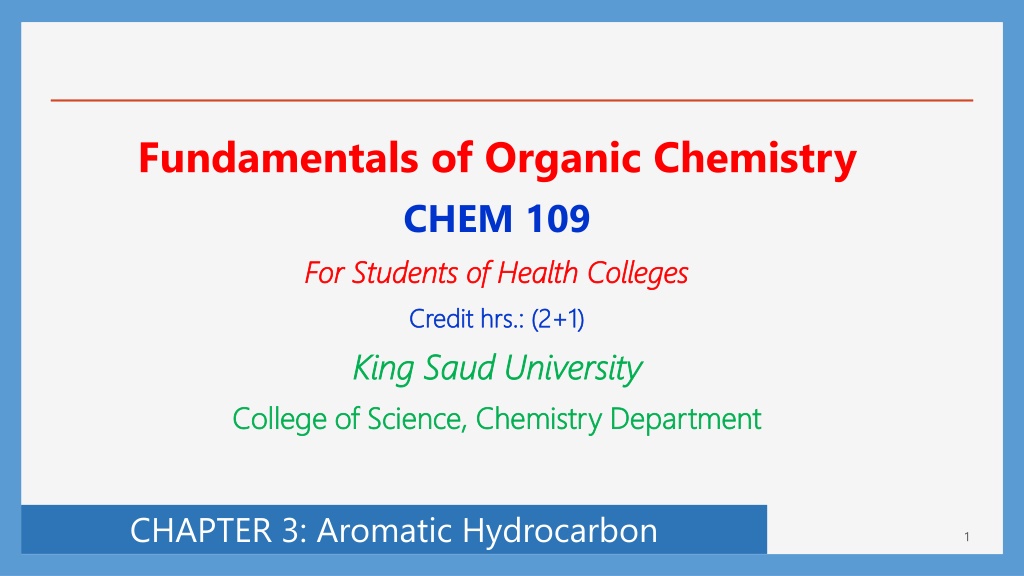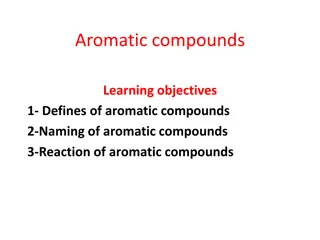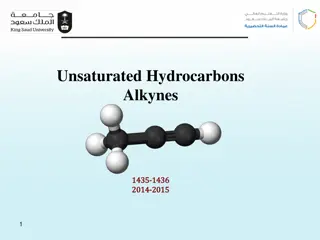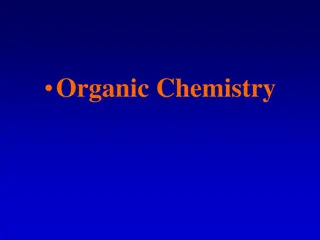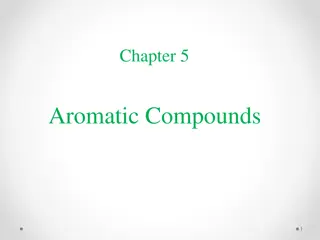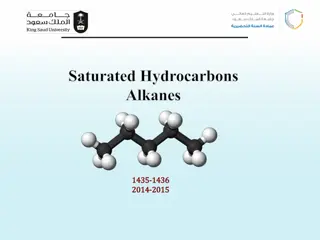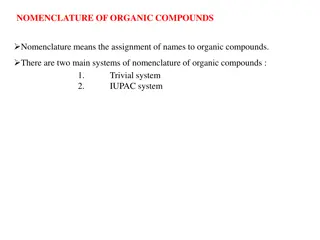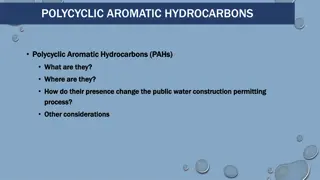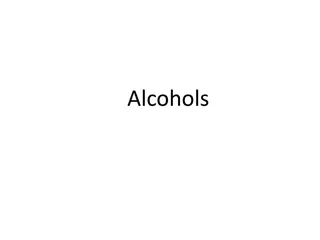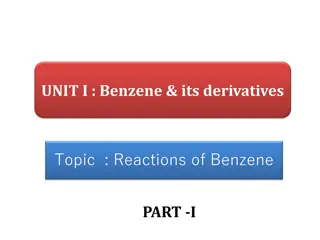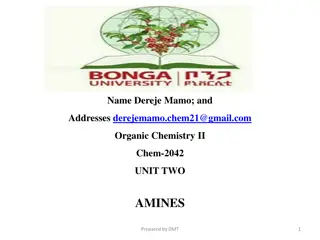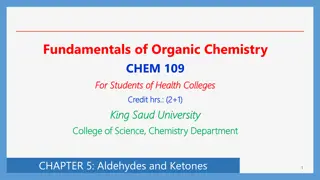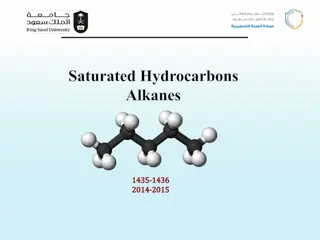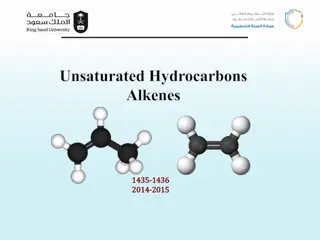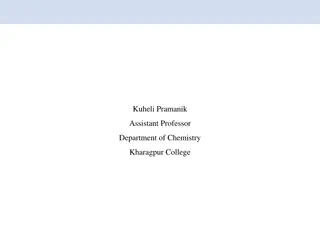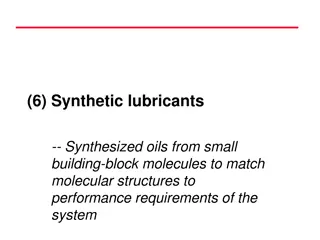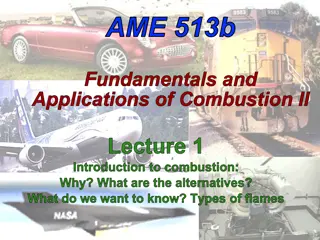Aromatic Hydrocarbons: Structure, Aromaticity, and Nomenclature
Aromatic hydrocarbons, with benzene as a key example, possess unique properties due to their highly unsaturated structures. The molecular formula of benzene is C6H6, and it exhibits resonance through a planar structure with sp2-hybridized carbons. To be classified as aromatic, a compound must have a cyclic structure with alternating double and single bonds, be planar, and follow Huckel's rule for the number of electrons. Understanding the structure and nomenclature of aromatic compounds is essential in organic chemistry studies.
Download Presentation

Please find below an Image/Link to download the presentation.
The content on the website is provided AS IS for your information and personal use only. It may not be sold, licensed, or shared on other websites without obtaining consent from the author. Download presentation by click this link. If you encounter any issues during the download, it is possible that the publisher has removed the file from their server.
E N D
Presentation Transcript
Fundamentals of Organic Chemistry CHEM 109 For Students of Health Colleges For Students of Health Colleges Credit hrs.: ( Credit hrs.: (2 2+ +1 1) ) King Saud University King Saud University College of Science, Chemistry Department College of Science, Chemistry Department CHAPTER 3: Aromatic Hydrocarbon 1
Aromatic Hydrocarbons o Originally called aromatic as many products posses distinctly non-fragrant smells! aromatic due to fragrant odors, although this definition seems inaccurate o Currently a compound is said to be aromatic if it has benzene benzene- -like like in in its its properties properties. o Benzene is the parent hydrocarbon of aromatic compounds, because of their special chemical properties. 2
The Structure of Benzene Ring o Molecular formula = C6H6 The carbon-to-hydrogen ratio in benzene, suggests a highly unsaturated structure. o Benzene reacts mainly by substitution. It does not undergo the typical addition reactions of alkenes or alkynes. o Kekul Structure for Benzene He suggested that six carbon atoms are located at the corners of a regular hexagon, with one hydrogen atom attached to each carbon atom. single and double bonds alternate around the ring (conjugated system of double bonds) and exchange positions around the ring. 3
The Structure of Benzene Ring o Resonance Model for Benzene. Benzene is planar. All of the carbon carbon bond lengths are identical: 1.39 A , intermediate between typical single (1.54 A ) and double (1.34 A ) carbon carbon bond lengths. Each carbon is therefore sp2-hybridized. Bond angles of 120 . 4
Aromatic Character (Aromaticity) To To be be classified classified as as aromatic, aromatic, a a compound compound must must have have: : Cyclic structure Cyclic structure contains what looks like a continuous system of alternating double and single bonds Aromatic compounds must be planar Fulfill Huckel s rule The number of electrons in the compound = (4n + 2) Where (n = 0,1, 2, 3, and so on). 5
Aromatic Character (Aromaticity) n 1 4n + 2 6 Structure and name of aromatic compound o Examples Examples 6
Nomenclature of Aromatic Compounds Monosubstituted Benzenes o Monosubstituted Monosubstituted benzenes are named as derivatives of benzene. benzenes that do not have common names accepted by IUPAC o Common names are accepted by IUPAC (parent compounds). 7
Nomenclature of Aromatic Compounds Disubstituted Benzenes o When two They are designated by the prefixes; ortho If substituent X is attached to carbon 1; o- groups are on carbons 2 and 6, m- groups are on carbons 3 and 5, and p- groups are on carbon 4. two substituents substituents are present, three isomeric structures are possible. ortho- - ( (o o- -), ), meta meta- - ( (m m- -) ) and para para- - ( (p p- -) ). . o Examples Examples; ; 8
Nomenclature of Aromatic Compounds Polysubstituted Benzenes o When more numbering the ring. more than than two two substituents substituents are present, their positions are designated by 9
Nomenclature of Aromatic Compounds o Two groups with special names occur frequently in aromatic compounds; the phenyl phenyl group group and the benzyl benzyl group group. . o Examples Examples; ; 10
Reactions of Benzene Electrophilic Substitution Reactions 1) Halogenation 4) Alkylation (Friedel-Crafts) 5) Acylation (Friedel-Crafts) 2) Nitration 3) Sulfonation 11
The Mechanism of Electrophilic Substitution Reactions We We can can generalize generalize this this two Reactions of Benzene two- -step step mechanism mechanism for for all all the the electrophilic electrophilic aromatic aromatic substitutions substitutions. . 1) Halogenation 12
The Mechanism of Electrophilic Substitution Reactions 2) Nitration In aromatic nitration reactions, the sulfuric acid catalyst protonates the nitric acid, which then loses water to generate the nitronium ion (NO2+), which contains a positively charged nitrogen atom. Reactions of Benzene 3) Sulfonation We use either concentrated or fuming sulfuric acid, and the electrophile may be sulfur trioxide, SO3, or protonated sulfur trioxide, +SO3H. 13
The Mechanism of Electrophilic Substitution Reactions 4) Friedel Crafts Alkylation The electrophile is a carbocation, which can be formed either by removing a halide ion from an alkyl halide with a Lewis acid catalyst (for example, AlCl3) . Reactions of Benzene 14
The Mechanism of Electrophilic Substitution Reactions 5) Friedel Crafts Alkylation Reactions of Benzene The electrophile is an acyl cation generated from an acid derivative, usually an acyl halide. The reaction provides a useful general route to aromatic ketones. 15
Reactions of Benzene Disubstituted Benzenes: Orientation o Substituents already present on an aromatic ring determine the position taken by a new substituent. o Example Example; ; nitration of toluene gives mainly a mixture of o- and p-nitrotoluene. o On the other hand, nitration of nitrobenzene under similar conditions gives mainly the meta isomer. 16
Disubstituted Benzenes: Orientation& Reactivity Reactions of Benzene Directing Directing and functional functional groups and activating activating effects groups effects of of common common Substituents that release electrons to the ring will activate the ring toward electrophilic substitution. Substituents that withdraw electrons from the ring will deactivate electrophilic substitution. the ring toward 17
Side-Chain Reactions of Benzene-Derivatives 1. Halogenation of an Alkyl Side Chain 18
Side-Chain Reactions of Benzene-Derivatives 2. Oxidation of an Alkyl Side Chain o Conversion into a carboxyl group, -COOH, by treatment with hot potassium permanganate. o Regardless the length of the alkyl chain, the product is always the same. 19
